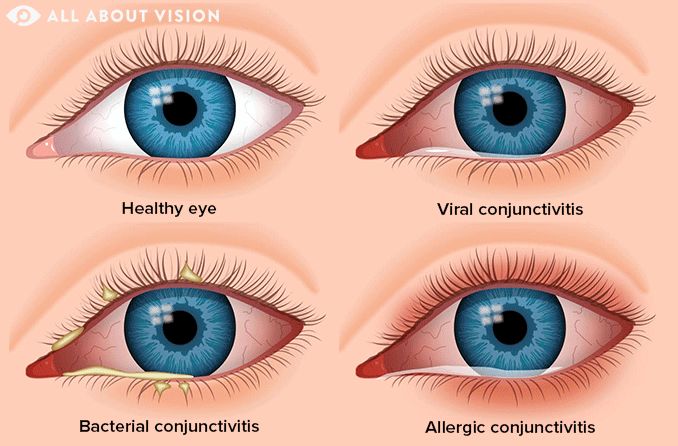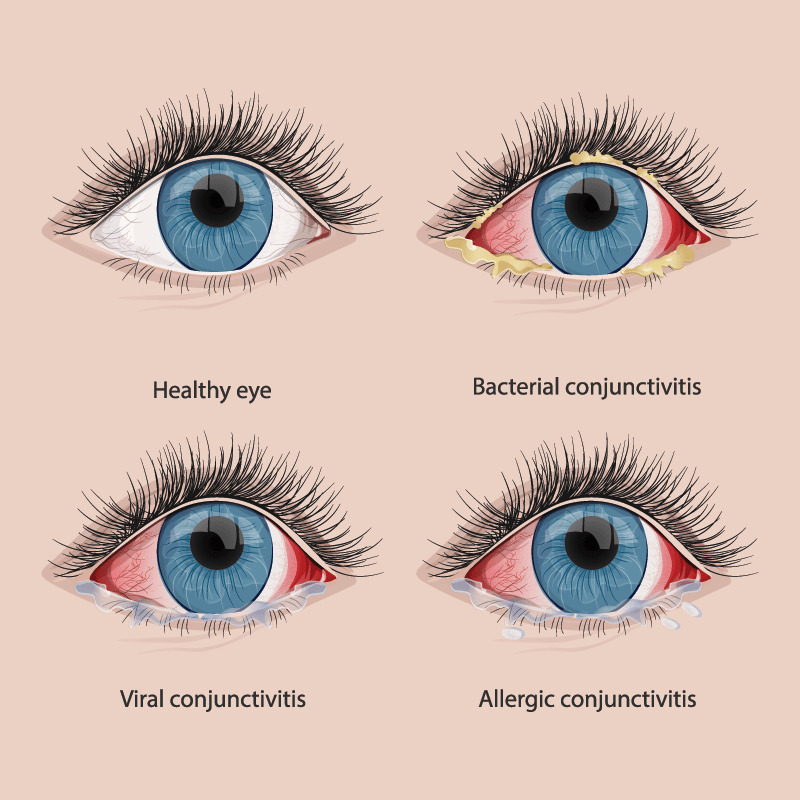Bacterial vs. viral conjunctivitis: What is the difference?
Eye redness, weeping, and discharge are signs of conjunctivitis caused by both bacterial and viral infections. The eyelids may stay together due to a heavier discharge brought on by bacterial conjunctivitis, though. It could also result in eyelid pain and edoema.

Differentiating between bacterial and viral conjunctivitis can be challenging. However, those who develop viral conjunctivitis typically have either experienced a viral disease themselves or have just come into touch with someone who has. This can aid medical professionals in differentiating.
While both types of conjunctivitis can improve on their own, bacterial conjunctivitis may require antibiotic eye drops. Fewer common bacterial conjunctivitis strains can spread quickly and necessitate immediate medical attention.
Viral conjunctivitis
The conjunctiva, a thin membrane lining the inner surface of the eyelids and the white area of the eyeball, becomes inflamed as a result of conjunctivitis, sometimes known as “pink eye,” an eye infection. Conjunctiva serves as a defence against infections and keeps the eye moist.
The conjunctiva itself, however, can occasionally become infected. Doctors refer to the ailment as viral conjunctivitis when a virus is to blame. Viral conjunctivitis can be brought on by a number of viruses.
- respiratory infections are brought on by the adenovirus
- Herpes simplex virus (HSV), which can lead to genital herpes or cold sores
- Virus called varicella-zoster, which causes chickenpox
- Measles is brought on by the rubeola virus.
- picornaviruses
The conjunctiva can become infected by a virus, which can then multiply and cause symptoms like:
- Having red eyes or eyelids
- scorching and itching
- tears or a watery sputter
- the impression of something strange in the sight
- sensitivity to light
Adenovirus is the most typical cause of viral conjunctivitis. While suffering from a typical cold, some people can get conjunctivitis. The symptoms of a cold typically go away on their own without medical intervention. It could take 14–30 days for viral conjunctivitis to go away.
Bacterial conjunctivitis
When bacteria invade and irritate the conjunctiva, bacterial conjunctivitis develops. This form of conjunctivitis is more likely to affect certain individuals, such as:
- children
- older people
- wearers of contact lenses
- individuals with compromised immune systems
The most typical bacterial species that cause bacterial conjunctivitis in kids are:
- the influenza virus
- pneumococcal streptococcus
- Catarrhal Moraxella
Staphylococcal bacteria are the most frequent species to cause the disease in adults. These germs can enter the eye via:
- interaction with an individual suffering from bacterial conjunctivitis
- touch with items that the affected person has used in the past
- exposure to respiratory droplets from sneezes or coughs
- alterations in the conjunctival bacteria
Similar to viral conjunctivitis, bacterial conjunctivitis can also cause the following symptoms:
- eyelids clump together because to a thick green or yellow discharge
- edoema of the cornea
- Painful and swollen eyelids
- reduced vision
Viral pink eye vs. bacterial pink eye
Viral pink eye can be contracted when someone sneezes or coughs and the droplets come into contact with your eyes, or it can spread from the nose to the eyes.
Pink eye caused by bacteria exists. Usually, the bacteria enters your eyes through your skin or respiratory system. Additionally, bacterial pink eye can develop if you:
- Use dirty hands to contact your eyes.
- application of bacteria-contaminated cosmetics
- sharing private goods with a pink eye sufferer
When an upper respiratory infection, such as a cold (virus) or sore throat, first develops, both types of pink eye frequently follow (virus or bacteria).
The same general signs and symptoms are present in both bacterial and viral pink eye, including:
- White of the eyes are pink or crimson.
- tearing
- itchiness or scratchiness in the eyes
- swelling
- burning or annoyance
- eyelids or lashes that are crusted, especially in the morning
- fluid coming from the eye
Here are several methods for determining the sort of pink eye you have.
Viral pink eye:
- typically begins in one eye but can progress to the other
- begins with a respiratory illness or cold
- produces ocular discharge due to water
Pink eye due to bacteria:
- can begin with an ear infection or respiratory infection
- one or both eyes are affected
- causes the eyes to clump together and produce a thick discharge (pus).
A sample of the discharge from your eye can be taken by your doctor and sent to a lab for testing to determine whether you have a bacterial or viral infection.
Treating pink eye
The majority of bacterial and viral pink eye illnesses will clear up on their own in a few days to two weeks. In the meanwhile, treat the symptoms as follows:
- To avoid dryness, use artificial tears or lubricating eye drops. (Eliminate the bottle once your infection has subsided to prevent self-reinfection.)
- To reduce swelling, apply warm, moist compresses or cold packs to your eye.
- Use a wet washcloth or tissue to wipe away the discharge from your eyes.
Your doctor may recommend the following medications if your pink eye is more severe:
- Antiviral medications may be effective in treating viral pink eye brought on by the herpes simplex or varicella-zoster virus.
- Pink eye caused by germs can be cleared up with the aid of antibiotic eye drops or ointment.
Once pink eye has cleared completely, follow these instructions to prevent reinfection:
- If you used eye makeup or cosmetic implements while you were afflicted, throw them away.
- Discard any disposable contact lenses and pink eye treatment you used.
- Clean and sanitise cases, glasses, and hard contact lenses.
Pink eye prevention
Pink eye spreads quickly. To prevent acquiring or spreading the infection:
- Use an alcohol-based hand sanitizer or often wash your hands with soap and warm water throughout the day. Before and after using eye drops or inserting contact lenses, wash your hands. If you come into contact with an infected person’s eyes, clothes, or other private items, you should also wash your hands.
- Avoid rubbing or touching your eyes.
- Share personal stuff like towels, blankets, pillowcases, cosmetics, and makeup brushes sparingly.
- After using them, wash your sheets, towels, and washcloths in hot water.
- Clean your glasses and contact lenses thoroughly.
- Stay at home from work or school if you have pink eye until your symptoms subside.
REFERENCES:
- https://www.healthline.com/health/how-long-does-pink-eye-last
- https://www.medicalnewstoday.com/articles/bacterial-vs-viral-conjunctivitis
- https://www.insider.com/guides/health/conditions-symptoms/viral-vs-bacterial-pink-eye
For more details, kindly visit below.
